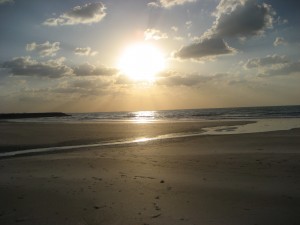 Two years ago this winter, I was trying to figure out why the high tide seems to usually fall on winter mornings where I live, and the low tide on winter evenings. I promised that if I solved this mystery, I’d post an animation about how it worked.
Two years ago this winter, I was trying to figure out why the high tide seems to usually fall on winter mornings where I live, and the low tide on winter evenings. I promised that if I solved this mystery, I’d post an animation about how it worked.
But while reader Stephan Zielinski provided plenty of help, I didn’t get very far on my promise–as has been the case with many New Year’s resolutions past, I came in with enthusiasm and sputtered out like so many firecrackers.
So this year I’ve come up with a new resolution, that nicely encompasses a wide variety of areas: try again. Keep trying.
For some additional inspiration and expertise in mystery solving, tonight I’ll tune in to the premiere of a new Sherlock special. And that’s what I wish for in 2016: a few mysteries revealed, and new ones to send me down the winding path of wherever they decide to go.
**
This weekend the moon pulled back the curtains on the beach, revealing plenty of sand in the evening hours. I love the beach in the winter, particularly near dusk. The sand seems to go on for miles; when there’s a full moon, it rises from behind the mountains, which are still rosy from alpenglow.
I think I understand how tidal extremes work, enough so that I can explain using a stick drawing in the sand. The moon and the Sun and the Earth fall into line (or close enough), giving a little extra tug on the tides. These higher highs and lower lows are called spring tides, ones that “spring forth” around the time of the new and full moons.
But I haven’t yet figured out why the beach seems to appear mostly in the evening in the wintertime, while it’s drowning in seawater near dawn. I might not have noticed this was happening at all, except that the first year we moved here, a fellow dog walker clued us in. “It’s winter time,” he said, as we headed toward the ocean. “The beach will be covered.” He pointed us to the grassy fields at the community college.
 Why do the highest tides in winter tend to fall in the morning, making it tricky to walk dogs and too swamped to surf before the kids wake up? The truth is, I was planning on figuring that out in this post, but I’m not sure that I can. I’ve read that in winter, the higher high and higher low tides are in the morning—which could make it seem like the tide is always “high” in the morning. But I still don’t know why that is.
Why do the highest tides in winter tend to fall in the morning, making it tricky to walk dogs and too swamped to surf before the kids wake up? The truth is, I was planning on figuring that out in this post, but I’m not sure that I can. I’ve read that in winter, the higher high and higher low tides are in the morning—which could make it seem like the tide is always “high” in the morning. But I still don’t know why that is.
These are the clues I have so far (some may be red herrings):
- The Earth is at perihelion, or closest in its orbit to the sun, around January 3.
- I am in the Northern Hemisphere, where the Earth’s axis is tilted away from the sun in winter.
- We have semidiurnal mixed tides—so two highs and two lows each day, with the highs and lows of different sizes.
- Events seem to conspire to prevent me from surfing. Take today: decent northwest swell coming in, and me with a head cold.
I have found some basic explanations online, but trying to sort them out makes me want to crawl into bed, and I already am. So if any would-be Sherlock (or Watson) is so inclined (not declined—could this be another clue?), I’d be most grateful if you’d post the explanation in the comments.
**
Images from Wikimedia Commons contributors Iardo and Theresa Knott
I suspect that a quick look at a tide chart will confirm that the high tides cycle through the hours of the day in their normal pattern (every twelve and a half hours?) no matter what season it is. Perhaps there’s some unconscious perceptual bias that makes you and others seem to notice it more when it occurs in the mornings? Or, something about winter beach sand volume that makes the high tides feel higher (covering more of the beach)?